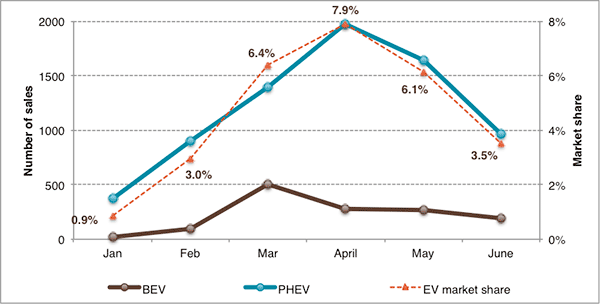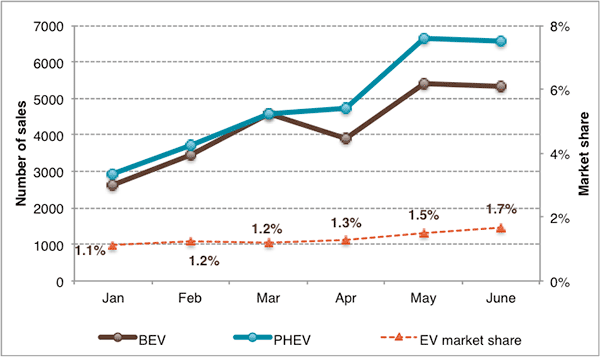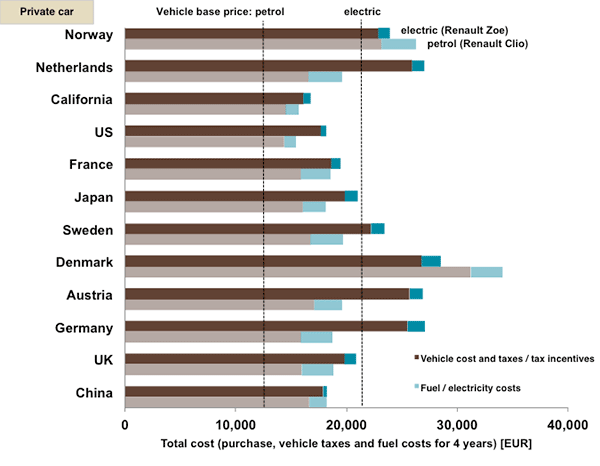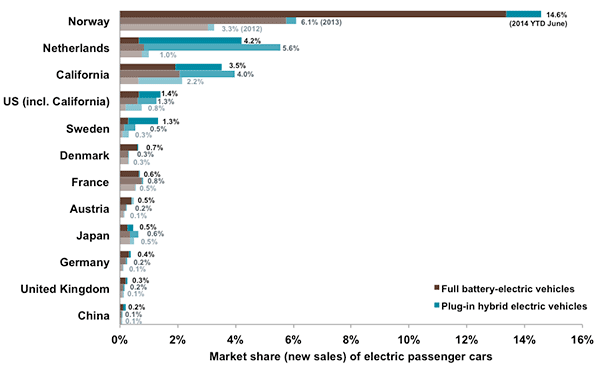Blog
Electric vehicle markets have their ups and downs (2014 YTD update)
In this study published earlier this year we ranked electric-vehicle market shares in 12 regions in 2012 and 2013 and summarized tax credits and other incentives available to EV buyers. But policies expire, and new policies kick in, so we continue to monitor these markets.
The first 6 months of 2014 have seen an interesting divergence in the top two EV markets, Norway and the Netherlands. The EV market share in Norway nearly hit 15% of new vehicle sales in the first half of 2014, compared to 6% in 2013. The market share of EVs in the Netherlands, on the other hand, dropped from 5.6% in 2013 to 4.2% in 2014. In Sweden the EV market share tripled, surpassing France, Japan, and California, where sales were steady compared with the last year. EV sales grew modestly in other markets (Denmark, Austria, Germany, the UK, and China).
So, what’s going on? Let’s take a look at some of the most interesting markets.
Norway
With a generous tax break and other strong non-fiscal incentives in place, EV sales in Norway continue to gallop ahead. EV sales in the first half of 2014 (about 10,488 units) exceeded total 2013 sales, with battery electric vehicles (BEVs) still dominating the EV market. But plug-in hybrid electric vehicles (PHEVs) are catching up, possibly due to the increase of the weight deduction allowed in calculating the weight-based registration tax from 10% to 15%, which reduces the tax disadvantage for PHEVs of the necessary additional battery weight. The tax breaks, which enable huge price advantage of BEVs, will remain in place until the end of 2017 or until the 50,000 EV target is achieved. At present, there are more than 30,000 EVs on the road in Norway. Interestingly, one successful non-fiscal incentive, access for EVs to bus-only lanes, has begun to generate some controversy, as buses struggle to keep on schedule with so many EVs in the bus lanes, especially during rush hour.
The Netherlands
Through the end of 2013, cars given by companies to employees for private use were exempt from the tax charge normally levied on such company cars if they emitted less than 50 g/km CO2. That tax incentive expired at the beginning of this year, and anticipation of the change stimulated a big jump in EV sales at the end of 2013 followed by, as expected, a rapid decline at the beginning of 2014. Still, the rates at which low-emission vehicles are taxed (4% or 7%) remain lower than for other company cars (14% to 25%), providing some fiscal incentive. As was the case last year, PHEVs dominate the EV market (see figure below).

2014 EV sales in the Netherlands
Sweden
The growth of EV sales in Sweden reflects the success of the Mitsubishi Outlander PHEV in the first half of 2014. Sales of this newly launched, competitively priced hybrid SUV almost doubled every month (except May), and it was the second-best-selling SUV in June. The Swedish government currently provides up to 4,600 EUR direct subsidies to passenger vehicles with CO2 emission less than 50 g/km. Since that incentive went into effect in 2012, registrations of these “super green cars” have increased dramatically (500 registered in 2012; 1,546 registered in 2013; 1,578 registered in 2014 as of July 15). But the incentive is slated to expire when 5,000 vehicles in total have been sold, i.e., it will be available only for an additional 1900 vehicles. Since it is unclear whether the incentive will be extended, we can expect a further spike in EV sales in Sweden for the rest of 2014, similar to that observed in the Netherlands last year.
United States
In the US, electric vehicles continue to show a small but steady gain in market share. An increase in PHEV in California sales in March was likely aided by the rush to get the last of the “green” stickers giving PHEVs special access to high-occupancy-vehicle (HOV) lanes there: the state reached the initial quota of 40,000 stickers in April, but a bill passed by the state legislature increased that quota by another 15,000 beginning July 1. A more general increase in EV sales nationwide is likely linked to significant price cuts. For example, in just the last few months Mitsubishi reduced the price of the i-MEV by $6,100, Toyota dropped the price of the Prius PHEV $2,000–$4,500, and Ford cut the price of its Fusion PHEV by $4,000. Many EVs are available for lease for a monthly cost of just $200.

2014 EV sales in the US
United Kingdom
Although its EV market is still small, the UK has an ambitious vision for increasing the share taken by ultra-low-emission vehicles (ULEV). To that end, the government has launched an incentive program to support ULEV between 2015 and 2020. It plans to allocate £500 million to finance direct subsidies to 50,000 EV purchases before 2017, and support additional non-monetary policies such as R&D and infrastructure as well.
China
The EV sales in China increased compared to last year, even though the market share hasn’t changed a lot due to China’s large new passenger vehicle base. Since EVs have become a central feature of automotive industry roadmaps, a number of cities have taken actions to promote EV sales, such as setting EV sale targets, permitting EVs to use special driving lanes, exempting EVs from traffic restriction, or accelerating infrastructure deployment etc. Moreover, on July 14, 2014, the State Council issued a Guiding Opinion on Accelerating the Promotion and Application of New Energy Vehicles. Under this new guideline, new energy vehicles sold from September 2014 to December 2017 will be exempt from the 10% vehicle acquisition tax. This exemption applies to both domestic and imported vehicles, which marks a departure from the traditional policy (such as direct subsidy to EVs) that favored domestic brands. As the vehicle acquisition tax is the largest vehicle-related tax in China, this incentive further reduces the price gap between EVs and conventional vehicles. The figure below reflects the total cost of the ownership of Renault Zoe (BEV) and Clio (gasoline) in different countries in 2013 (except China is updated to 2014), including identical base price, one-time vehicle tax, subsidies, annual vehicle taxes, and fuel/electricity cost for a time period of four years. After the new tax break, the total cost of Zoe drops €1,800 to the same level as Clio. Could this latest incentive accelerate EV sales in China? Stay tuned.

Summary of Total Cost of Ownership calculations for Renault Clio vs. Zoe (private car market)

